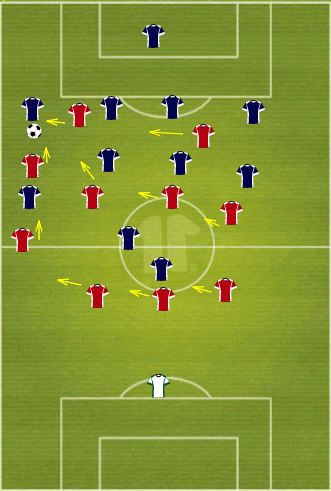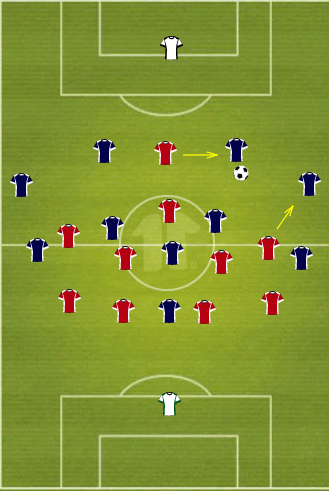Taken from the book:
*
“The opposition must be offered no way out. A possession game – Barcelona’s game – requires you to win possession in the first place”
The Guardian’s Sid Lowe on Pep Guardiola’s defensive pressing philosophy at Barcelona
Defensive neglect
It is heard at almost all levels (in all sports)… the cliché of ‘attack wins games, defence wins championships’, yet do people really understand the impact of this and the true importance that defending has on success?
Since the turn of the century football has progressed in many areas, and much attention has been given to what happens when a team is in possession. In fact, the rise of ‘tiki-taka’ with Barcelona and the obsession that the media and fans have with goalscorers and attackers points to a cultural emphasis on attacking. The purists will argue that attacking football is how football should be played, yet do we understand what this means?
Zdeněk Zeman, the Czech coach who has worked predominantly in Italian football with Lazio, Roma and Foggia is a proponent of ‘all-out attack’ football; he simply seeks to score more than the opposition. Although such an approach is entertaining the truth is that it is simply not conducive for success. English football saw Kevin Keegan, while coach at Newcastle United in the mid-90’s, play a very attacking brand of football which was lauded as entertaining, yet he never managed to win anything. Both Zeman and Keegan sought to play a certain way yet neglected a key element to football: defence.
In fact when we look at the English Premier League over the last few years it has been home to a philosophy of attacking football. Many English sides, in recent history, have embraced this philosophy and it has resulted in some ludicrous scorelines between the top sides; scorelines which have pointed not so much to great attacking play but to a neglect of defending. This approach has coincided with a decline in the performances of English sides in the Champions League. Actually, it is no coincidence at all.
Simply put – defending as a team is essential for success, especially at the top levels of football. Quite frankly the top English sides forgot about this (we shall look at Chelsea’s Champions League success, and why they were successful, shortly).
Perhaps some fans enjoyed the Keegan years but, remember, he never won anything with his style. English football lost its dominance in Europe because defensive organisation, seen under the tutelage of coaches like Mourinho, Benitez and Queiroz in their times at Chelsea, Liverpool and Manchester United respectively, was diminished. As we’ve also discussed, these coaches were world class European tacticians who understood the importance of defending and being organised. It was no surprise that during the 2000’s their sides were dominating Europe. When all three left the Premier League, English football changed.
Roberto Di Matteo brought Chelsea European success in 2012 because he used the tactics which Jose Mourinho had previously instilled in his players. They defended resolutely to win the competition. Taking over from Andre Villas-Boas, a coach who sought a high pressing, possession-based style, Di Matteo changed Chelsea for the better in terms of their ability to win games. It was pragmatic and ultimately successful.
Compare this to Manchester City who, at the time, possessed some genuine world class players but who struggled in the Champions League. Why was this? Well it was because of their defensive approach. Their coach, Roberto Mancini, struggled for two seasons (2011-2013) in the group stages because of the way he set up his side to defend. His problem was that he failed to build an organised, tactically strong, cohesive side built for success in Europe.
What is needed at the top levels of the game, especially in Europe, is organisation and having a strategy when out of possession. In games against Real Madrid, Dortmund and Ajax the opposition all found holes and flaws in Manchester City’s armour. Under Mancini, the team lacked cohesion, organisation, and discipline! Although he had top notch players in Vincent Kompany, Yaya Toure, David Silva and Sergio Aguero – Mancini’s problem was that he put his trust into individuals, hoping or expecting them to produce moments of magic to win games. This may work in the Premier League but in Europe it requires a much stronger team performance, especially when you do not have the ball.
City struggled in Europe with Mancini because the defence manifested itself as ‘disorganised individualism’. Setting up in a 4-2-3-1 (like other top sides across Europe) they didn’t have a defensive strategy; when to drop, where to drop, and who to press. In order to succeed, and even win a game at the top level, these tactical elements have become essential.
Mancini had struggled before in Europe – when at Inter Milan – where his tactical naivety reflected his reliance on individuals. Inter struggled in the competition in a similar way to City yet when Mancini was replaced by Jose Mourinho, Inter would win the Champions League. Why? Because Mourinho understood the importance of being a strong and cohesive team. The lesson about success in Europe is clear; the whole overcomes the parts, no matter how good those individual players are.
In the 2013/14 season English football has seen the return of Mourinho to Chelsea and Manuel Pellegrini installed at Manchester City with both coaches bringing a wiser approach to their teams through their tactical understanding. These are coaches who appreciate the needs of the modern game. Even Arsène Wenger has seen the importance of being stronger defensively.
In his quest to replicate Barcelona, Wenger forgot (or neglected) the biggest factor as to why Barcelona are so great. Barcelona (and Spain) are world class defensive sides. Wenger’s defensive inattention led to Arsenal being a shambles when out of possession; they didn’t press quickly to stop counter attacks, they didn’t press from the front, or drop off and deny space. The midfield looked disorganised and clueless when out of possession and they allowed too many 2v1 situations. They also failed to deal effectively with long balls and crosses. It was a defensive shambles.
Cesc Fàbregas summed it up when he spoke of the ‘freedom’ Wenger afforded him, something which the tactically astute and successful coach Guardiola was furious with. The Spanish are tactically as good as they are technically. Their ability on the ball is excellent, their movement and timing is mesmerising, yet their tactical discipline to keep their defensive shape, always focused on their tactical roles, is a reason why they have achieved as much as they have.
Wenger’s failing was that he saw only passing, and ability on the ball. Without a defensive foundation, a side will not win anything.
It is clear that the rise of, and need for, a collective approach for sides, especially when defending, has become the main formula for success in the modern game. Barcelona proved that during their dominant years. Bayern embraced it and became Europe’s best side. And Germany have reached the top of the world with their success, in Brazil, primarily through their collective spirit and togetherness. The future game will only increase this need for cohesion.
*
Are you a soccer coach? We have more than 25 titles currently available.
Spain’s defensive might
At the 2012 European Championships there was an appreciation of a strong defence by some, and a general disregard of it by others. No surprise that those who prospered at the tournament did so on the back of their impressive defensive setups, notably the finalists: Italy and Spain. In turn, there were some quite awful displays of defending; Ireland in particular were abysmal, especially considering they came into the tournament on the back of such a resolute defence. Under Giovanni Trapattoni they were a shambles and deservedly eliminated in the group stages.
Another side which disappointed greatly was Holland. The Dutch were arguably the best side in the tournament when in possession; their speed of play, movement, and their skill on the ball was scintillating at times yet it was what they did defensively which led to their knockout in the group stages. In their game against Germany, their defending meant Germany took all three points.
Both sides played a 4-2-3-1 yet Holland seemingly neglected to focus on team defending. Holland’s problems came from their chaotic defence and a lack of balance in midfield. A lack of midfield overload, the wrong type of players in various positions and, importantly, a lack of team defending cost the side qualification from the group. Compare this performance to their World Cup performance two years later and you see the difference in approach which van Gaal provided. They looked stronger, more resolute, and worked as a team.
When you consider the importance of collectivism then you can see why Spain have dominated international football since 2008. Their progression from a 4-3-3 under Luis Aragonés to a ‘false nine’ 4-2-4-0 under Vicente del Bosque, at the 2012 Euros, showed a growing maturity and controlled approach to games. With Sergio Busquets and Xavi Alonso playing as holding midfielders, Xavi and Iniesta centrally above them, Silva wider and Fàbregas as the ‘false nine’ – Spain simply dictated their games in the midfield.
Like Guardiola at Barcelona, del Bosque sought to fill his side with midfielders, at the expense of a ‘true’ forward. This tactic did not offer significant penetration throughout the tournament yet it allowed Spain to do what they wished for; control the midfield area and remain defensively strong (they did not concede a goal in any knockout game from 2008-2012; a quite astounding statistic). The tactic would also help prevent the onset of fatigue such that their command of possession and enhanced fitness would see Spain win the 2012 Euros tournament, annihilating an exhausted Italy 4-0 in the final.
And why did Spain fail so poorly at the 2014 World Cup? Well they lost their belief in their style of play. In Diego Costa they had a player who thrived playing a counter-pressing style. And the problem was that del Bosque could not just put such a player into the team and create a counter-pressing side. Spain played a confused style, not sure whether to dominate possession or use Costa’s attributes. Spain looked like a side who didn’t know who and what they were anymore. This is what cost them.
From 2008 to 2012 they knew who they were, they built their dominance and confidence from this. Yet in Brazil they looked scared, unsure and ultimately weak. Costa’s introduction not only affected the balance and, perhaps, the harmony of the side but it rocked the fabric of the Spanish philosophy.
If del Bosque wanted to embrace a more counter-pressing strategy he would have been better suited playing players like Fàbregas, Pedro, and Koke (with Costa) as they are more vertical and direct in their play. He added a piece which was not going to work yet was not brave or willing to make the additional changes in style and personnel to make it work.
During their prevailing and successful years Spain and Barcelona would dominate midfield with their possession-based game. The tactic is not only a way to find space to penetrate the opposition it is also a defensive tactic in order to ‘rest in possession’. Spanish football’s emphasis on a high pressing approach is a tiring tactic for players thus resting when in possession is essential to keep a team’s energy levels up.
During Barcelona’s dominant period they became more and more fatigued (long term) as a unit which resulted in an overuse of their ‘tiki-taka’ football; it became common to see Barca have 70%+ possession in games. It was a near admission that they were conscious and fearful of losing the ball and having to work hard to win it back. As highlighted earlier, most of their players had not properly rested since the summer of 2007 due to international tournaments where they reached the finals each time, and pre-season tours to help market the club’s brand.
At the 2014 World Cup Spain gave away possession too cheaply and were punished in transition, particularly by the Dutch in their 5-1 destruction of the Spaniards. The players were exhausted and unable to press to win the ball back, a tactic which had been their most essential weapon previously.
High Pressing
For some in the game there is a misconception that the term ‘defence’ means ‘defenders’, this is wrong and those who stick to this idea are more likely to lose more games than they win. Defence is what the team does when not in possession of the ball. Effectively defence is a collective effort by the whole team. What Barca did better than any side before them was their ability to press as a team.
High defensive pressing is the style that Rinus Michels developed in Holland with Ajax in the late 60’s, and is a method which Arrigo Sacchi’s Milan mastered so well for great success, and which Barcelona and Spain recently perfected. This style means that, as a team, you press high up the pitch in order to win the ball back. Its value is that you prevent the opposition counter attacking and, if you win the ball back, you are closer to goal.
A high pressing game requires many factors to come together to be highly effective; notably it requires a collective approach and a deep understanding of the roles and positioning of all players. It also requires supreme fitness and a willingness to work hard and be selfless for the good of the team. It is a tactic that requires a real intelligence, an understanding of the triggers of when to go, where to show, and where to support.
Interestingly, English sides have often attempted a high pressing game; Graham Taylor’s Watford in the 1980’s were renowned for it, however what this side and many English sides lack, is the actual knowledge of how to press. A gung-ho approach was often how English coaches viewed ‘pressing’, which was easy to play around for most sides, as it lacked intelligence or strategy. Contrary to the English mentality – pressing does not mean running around like a lunatic hunting for the ball. It requires astuteness and understanding.
The truth is that not many sides can achieve success playing a high pressing game, yet if a good coach can impress this style on their team, the rewards are there. This is why Guardiola should be complimented for his ability to make it work so effectively when at Barca. Alex Ferguson remarked after the 2011 Champions League final that the way Barca pressured their opponents to win the ball back was “breath-taking”.
Of course the downfall to this defensive style is the vulnerability behind the defence as the defensive line is very high. Thus it is important to have quick and intelligent defenders, who are adept at playing 1v1s. It is vital they can read and win the ball if the opposition play a longer clearance out. On top of this is the need to have a goalkeeper who acts like a sweeper, being able to read and clear up in the (massive) space allowed behind the defensive press. Yet Guardiola wanted his forwards to work hard to stop this happening. Here’s how.
Firstly, the initial press. Importantly Barcelona started pressing the instant they lost possession. Of course that is the perfect time to press because the opposing player who has just won the ball has exerted energy in winning possession and does not have a clear idea of what decision he will make now he has the ball. Barcelona therefore attempted to dispossess (or at least rush) the player before he could give the ball to a better-placed teammate and start an attack.
The key is that Barca pressed in packs which was made easier thanks to their possession-based style. Because they passed over short distances of 10-15 yards there were always several players around the ball, so if they lost possession, there would be a number of players able to press quickly to win it back. If only one or two players press, it’s too easy for the opponent to pass around them. Team defending, working as one, this is the key.
Now if Barca hadn’t won the ball back within five seconds of losing it, they would retreat and build a compact ten-man wall behind the ball in order to prevent the opposition playing through them. It was methodical and well drilled. The players nearest to the ball pressed to stop an attack yet those further away took up their defensive positions to close the space and compress the team. In a similar mentality to Sacchi at Milan the distance between the front man in the wall and the last defender was meant to be only 25 to 30 metres.
This defensive setup has become the hallmark of the gegenpressing strategy which we will come to next. Yet Barca were the team most adept at playing a high press and a mid-press effectively. In fact in the final in 2009 against Manchester United, after Barca had taken the lead, they opted to defend with this deeper ‘wall’, nullifying the space for United to play through and behind. It was eleven precisely positioned opponents and it prevented United creating many chances.
When Barca were set up in this defensive block they simply waited for a chance to press once more. The tactic is all about waiting for the right moment to press again. The moment is not chosen on instinct, there are very precise prompts that tell them when to press; a trigger such as a poor touch, or a player’s head going down can be the time to go and press again. Or it could be that the team seek to shepherd the ball to a player or area of the pitch where they can press once more. It is very intelligent and very effective. And it is these principles which have helped counter-pressing become such a formidable tactic in recent years.

(Image) An example of Barca’s high pressing game in transition. The full back has won the ball back yet is confronted by four players around the ball immediately. Look, also, at how the defence is set up – as a back three – with the holding midfielder supporting in front and the goalkeeper’s position higher up to play as the keeper sweeper if necessary. This should allow the team to stop the opposing team playing forward and attacking as well as seeking to win possession back by forcing an error.
Gegenpressing
Now although there are different ways to defend, the central element which is often lost on many coaches, fans and even managers, is that defending and attacking are not mutually exclusive. The most important moment in football comes in transition.
Jose Mourinho argues that transitions are the most essential part of the game: “When you lose the ball, you are most vulnerable, when you win it, you have your best chance to score.” Watch Spain and Barcelona at their best when they win or lose the ball and how quickly they transition, watch a Mourinho side when they win the ball in their own half… in a matter of seconds they are down the other end. This is how important, how crucial, transition is to football. Manchester United from 2006 to 2008 had perfected counter-attacking football with the speed of players like Ronaldo and Rooney. Put simply, the best side’s transition quickly and effectively. And this is where the success of gegenpressing has come from.
While Barcelona and Spain were showing the value in a high pressing game, coaches were looking for ways to counter their style and tactic. Jose Mourinho would use a deep defensive block with Inter Milan in the Champions League semi-final in 2010 to overcome Barcelona in the semi-final and Bayern in the final. His objective was to cede possession and territory higher up the pitch yet restrict space behind his compact block. It was seen as a masterpiece of defensive organization. He would continue this tactic with Real Madrid from 2010 to 2013, especially in the games against Barca. He was showing the value of counter-attacking football, of transition; it was not simply ‘defend-at-all-costs’ as others played against Barca.
At the same time, a new strategy was being developed which was focused on pressure and transition. We have spoken of gegenpressing previously, and will look more at how this style has become popular and successful in recent years.
It was Jürgen Klopp at Dortmund who developed and executed the ‘counter-pressing’ tactic to great effect. In the makeup of the 4-2-3-1 Klopp would work on the defensive organization of his side to nullify space behind the defence as well as making it difficult to play between them. Dropping his forwards off to a point 10 yards ahead of the halfway line, he would allow the opposition to have the ball in their defensive third, the aim being to draw the opposition into the mid-third and then to pounce with frightening speed and intensity in order to win the ball back and counter.
This compact mid-block meant there was a lack of space for the opposition to penetrate through and behind. Setting out in a 4-4-1-1 formation the team would make a strong defensive block which was tough for sides to break down and penetrate through. Of course the aim was to draw the opposition in, win the ball back and transition with frightening speed. Dortmund’s counter attacks were truly incredible to watch.
Now an important part of this tactic is the effectiveness of the centre forward. Their ability and dynamism to press when out of possession is central to the success of the tactic. It was not about winning the ball but being able to force the play, contain the opposition, and force errors. To be successful the forward must be a hard worker and sharp in his approach.

(Image) An example of how gegenpressing works. The centre forward seeks to force the central defender to play to the left, where the wide midfielder seeks to press and win the ball back. See the compactness of the team, preventing space in-between. The lack of space behind means any runs and passes over the block can be dealt with by the defence or goalkeeper.
We have seen already how Jupp Heynckes replicated Dortmund’s gegenpressing method in the 2012/13 season with Bayern and executed it to perfection. In the semi-final against Barcelona, and as mentioned in Chapter 4, Heynckes said Bayern were “tactically brilliant”. He was right. They were excellent too against Arsenal and Juventus earlier in the competition. He was talking about their execution when out of possession.
Using the gegenpressing strategy Bayern nullified sides who sought to play a possession-based game and punished them ruthlessly on the counter attack. Against Barca they would win 7-0 on aggregate. It was ruthless and suffocating pressure and proof that counter-pressing, when done right, could nullify ‘tiki-taka’.
Jupp Heynckes coached his side to know when to press and when to delay. The players understood how to force and contain the opposition, how to restrict space and how to nullify the opposition’s options. As mentioned in Chapter 4, Philipp Lahm called their approach (quite appropriately) “aggressive pressure” and this idea has become a focus of the modern game.
Of course, it is not too different to how Sacchi’s Milan and Guardiola’s Barca played; the ideas of collectivism, of a whole unit working together to apply pressure on the opposition, knowing the triggers of when and where to press.
And in the 2013/14 season we witnessed the rise of a new counter-pressing force in Atlético Madrid. Under the tutelage of Diego Simeone the club has propelled itself to the top levels of the European game. In 2012 Simeone took the side to Europa League success and then defeated Champions League winners Chelsea in the European Super Cup (4-1) in August 2012. The signs were there that Atleti were becoming a force, built on defensive organisation and using a deep defensive block, as well as utilising ruthless counter attacks.
In 2013/14 they would win La Liga (the first time a team other than Barca or Real Madrid had won it since Rafa Benitez’s Valencia in 2004) and reach the Champions League final. They were a minute from winning a historic double only to concede a set piece in the dying moments and lose in extra time. However Atleti and their coach had proved their credentials, in a similar fashion to Dortmund the season before; they had shown their ability to compete with the top sides. And their strength? An extremely organised defensive block with sublime transitional play.
Tiki-taka vs counter-pressing
Chelsea’s Champions League run in 2012 proved the value in approaching games with a level of pragmatism. How they setup against Barcelona, Bayern, and even Benfica was an admission that they could not compete with these sides by dominating the game with possession and long build-ups. They simply did not have the personnel to implement an open brand of football.
Roberto Di Matteo admitted their vulnerabilities and used their strengths to counter them. He went back to the method which had suited Chelsea so well for many seasons, with a mentality which was schooled by Jose Mourinho during his time at the club. Defend deep and compact, and counter attack with quick wingers and the power of a strong number nine.
Chelsea’s tactical decision to defend in numbers and to stifle any space and time for players like Lionel Messi was the correct decision in hindsight. However, this defensive approach has been criticised by the ‘purists’ of the game. Many fans and pundits accused Chelsea of not deserving the trophy. It appeared that the purists believed that the manner and style in which the trophy was won placed a shadow over the winners. Johan Cruyff stated, after Chelsea lifted the trophy, “A football team can forget everything and still win. I’d choose to take the steps we take at Ajax, towards the football that we all want to see.”
This is quite ludicrous. If Chelsea won the competition, then they deserved to… surely?!? Is Cruyff serious when he believes that it is better not to win if you play defensive football? Surely a good coach will change their formation or strategy to suit the game and opposition in an effort to improve their side’s performance and chances.
Cruyff, though, had learnt, as a coach, that stubbornness in one’s philosophy can prove costly. His ‘Dream Team’ lost 4-0 to AC Milan in 1994 when his reluctance to change things cost Barca the game. Capello’s tactics stifled Barca and Milan were ruthless on the counter attack. This stubbornness effectively ended Cruyff’s reign and prevented that side from going on to achieve more.
Di Matteo was pragmatic and he operated how he saw best… in very much the way of the man whose shadow lingered over Stamford Bridge: Jose Mourinho. Di Matteo adopted tactics which reflected the team’s strengths as much as the weaknesses of the side.
Yet based on what Barcelona have achieved, especially their consistent challenging for top honours, it appears that it is beneficial to value a possession-based game: to have the ball and dictate the game, rather than to trust the opposition not to score. If sides are serious about being one of the best and most consistent sides in Europe then do they need to develop a style which utilises a more possession-based style of football, and attack with fluency?
There will be those that say that possession-based football has been shown to be more effective because having over 60% possession in a game correlates to an increased rate of success (based on a large sample size of games). In the past decade, in particular, possession statistics have become obsessed over, with coaches like Arsène Wenger seeking to have over 60% in each game. Guardiola would take possession to another level at Barca and then at Bayern with consistent 70%+ possession in games. It seemed this is the model. Is it really? No, it appears not.
Recently we have started to see that sides are willing to allow the opposition to have possession of the ball. This means we are starting to see games where possession statistics mean little. The context of the game cannot be explained in ‘who had more of the ball’ because both sides are not seeking to have possession. What has become more important, especially in the higher echelons of the game, is creating and converting chances.
Ultimately possession doesn’t count for much unless you finish your chances. Of course if you have more possession this, statistically, increases your chances of scoring as you have more opportunities; however, we are really talking about the quality of chances created here.
Barca, during their highly successful period, made their possession count for something by producing a high number of high quality scoring opportunities. They showed patience, intelligence and great decision-making to convert possession into goals. Yet as they became more stifled by ever-improving oppositions those quality chances were reduced. And those who were able to counter more effectively started creating more chances. Possession started to become a problem, not a solution.
This strategy was shown to work, particularly for Inter and Chelsea in 2010 and 2012. In the semi-final against Barcelona in 2010 Inter held the ball for just 21.5% of the two matches, yet still managed to win 3-2 on aggregate. Even in the final (against Louis van Gaal’s Bayern Munich) Inter Milan had the ball for only 30% of the game, yet still won 2-0. It appeared to show that a defensive counter attacking strategy could succeed over an Ajax Totalfootball philosophy.
What is clear is that possession-based football may not be the answer to everything in the modern and future game. Teams have evolved into appreciating the value of allowing the opposition to have possession; being more defensively secure and denying the opposition good goal scoring opportunities appears more important. This approach may seem higher risk as you are giving your opponents the opportunity to have the ball (which may in turn create more chances) yet with improvements in team defending sides are showing more focus and discipline in their defending and greater intelligence and efficiency in transition.
Using possession stats to judge a team is wrong. You judge teams by their ability to convert their chances. You judge them by the final score. That is what matters. And this is where the rise of counter-pressing originated from. It is about denying the opposition chances and creating great chances to score in transition: it is quality over quantity. It is about controlling the game without possession.
Counter-pressing has become a model for success at the top levels of the game; with Chelsea, Bayern and Real Madrid winning the Champions League from 2012 to 2014. And with Dortmund and Atlético Madrid reaching finals too, it does seem that counter-pressing has overtaken tiki-taka football in the modern game. German football is now regarded as the pinnacle of world football and their World Cup success certainly pointed towards their ability to press and counter attack with ruthless precision and efficiency. However, Joachim Löw has seen the necessity of possession, and in controlling games with possession. He has sought to learn from Guardiola at Bayern and embrace both tiki-taka and counter-pressing in his side’s play. Germany showed versatility and variety in their tactical approach at the World Cup, a key reason why they won the tournament.
So while some have said that we are witnessing the death of tiki-taka through the exits of Spain and Bayern in the World Cup and Champions League last season, it is a slight exaggeration. Perhaps tiki-taka simply needs modernising? The game is developing at rapid speed and new styles and systems are being cultivated in order to counter opposition sides. The level of in-depth analysis and the rise of technology has catalysed the game’s evolution. The game of the future will require sides to be flexible, fluid and versatile. One style alone will not be good enough for success.
This look at modern defending points to one clear thing, one which differentiates between the good and great sides… their coaches. Their attention to detail in preparing their teams to defend and attack as a team has become paramount to success. There is the idea that setting up a side to be defensively organised is easy. This is not true. To get a team to defend as one, whether pressing high or dropping off, takes time, great coaching and importantly great persuasive skills. Success appears to rest on the quality of the coach. This is why coaches like Guardiola, Heynckes, Mourinho, Ancelotti, Klopp and Diego Simeone have become so successful. They have convinced their players to ‘buy in’ to their philosophy, to sacrifice the self for the team. Great coaching and great persuasion. And this is where we will look next.




